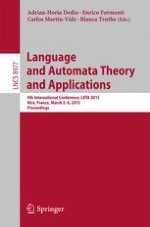This book constitutes the refereed proceedings of the 9th International Conference on Language and Automata Theory and Applications, LATA 2015, held in Nice, France in March 2015. The 53 revised full papers presented together with 5 invited talks were carefully reviewed and selected from 115 submissions. The papers cover the following topics: algebraic language theory; algorithms for semi-structured data mining, algorithms on automata and words; automata and logic; automata for system analysis and program verification; automata networks, concurrency and Petri nets; automatic structures; cellular automata, codes, combinatorics on words; computational complexity; data and image compression; descriptional complexity; digital libraries and document engineering; foundations of finite state technology; foundations of XML; fuzzy and rough languages; grammatical inference and algorithmic learning; graphs and graph transformation; language varieties and semigroups; parallel and regulated rewriting; parsing; patterns; string and combinatorial issues in computational biology and bioinformatics; string processing algorithms; symbolic dynamics; term rewriting; transducers; trees, tree languages and tree automata; weighted automata.
